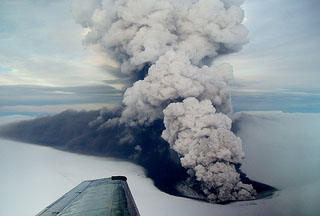Report on Grimsvotn (Iceland) — 1 September-7 September 2021
Smithsonian Institution / US Geological Survey
Weekly Volcanic Activity Report, 1 September-7 September 2021
Managing Editor: Sally Sennert.
Please cite this report as:
Global Volcanism Program, 2021. Report on Grimsvotn (Iceland) (Sennert, S, ed.). Weekly Volcanic Activity Report, 1 September-7 September 2021. Smithsonian Institution and US Geological Survey.
Grimsvotn
Iceland
64.416°N, 17.316°W; summit elev. 1719 m
All times are local (unless otherwise noted)
On 1 September the Icelandic Meteorological Office (IMO) stated that the water level of the Skaftá river at Sveinstindur (the closest gauging station at 28 km downstream from the ice margin) rose, suggesting the beginning of a Skaftárhlaup or glacial outburst flood (also called a jökulhlaup), that originated from [the Western Skaftá cauldron, about 20 km NW of Grímsvötn]. A sulfur odor was also noted in the vicinity of Skaftá and Hverfisfljót. IMO warned that hydrogen sulfide released from the floodwater as it drained from the caldera lake was particularly potent at the river outlet from the ice margin, where concentrations may reach toxic levels. The flow rate in the Skaftá peaked at 520 cubic meters per second downstream near the bridge at Eldvatn on 2 September and then declined to 412 cubic meters per second in the afternoon of 3 September. As a result, the ice shelf began to subside around 2300 on 4 September, dropping 1 m by 1145 the next morning, based on GPS data. On 6 September the discharge rate increased rapidly and peaked at 610 cubic meters per second at 1400, then declined later that day. Data suggested that the peak discharge rate on 6 September was due to a second release of water from the eastern part of the caldera lake. On 7 September the flow rate had increased to 520 cubic meters per second. Based on an overflight IMO concluded that the glacial flooding from both the E and W parts of the lake was smaller in volume and flow rates compared to a similar event in 2018.
Geological Summary. Grímsvötn, Iceland's most frequently active volcano in recent history, lies largely beneath the vast Vatnajökull icecap. The caldera lake is covered by a 200-m-thick ice shelf, and only the southern rim of the 6 x 8 km caldera is exposed. The geothermal area in the caldera causes frequent jökulhlaups (glacier outburst floods) when melting raises the water level high enough to lift its ice dam. Long NE-SW-trending fissure systems extend from the central volcano. The most prominent of these is the noted Laki (Skaftar) fissure, which extends to the SW and produced the world's largest known historical lava flow in 1783. The 15 km3 basaltic Laki lavas were erupted over 7 months from a 27-km-long fissure system. Extensive crop damage and livestock losses caused a severe famine that resulted in the loss of one-fifth of the population of Iceland.

